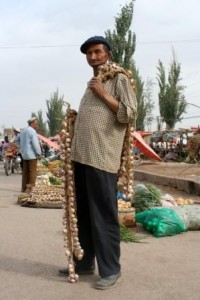Struggle at the Center of Asia: China vs. the Uighurs. Mike Jeffers Reports
By Mike Jeffers
(Editor’s note: Our reporter made two journeys to Xinjiang; first in the summer of 2008, then again six months later, in December 2008 and January 2009. This article grew out of those visits – his personal narrative appears in italics.)
I awaken from a deep sleep to a broad view of desert plants poking out of rocky terrain. Sheep graze on a distant hillside, and every so often an oil rig disrupts the scenery. I briefly think I’m in the vast stretches of West Texas I used to traverse as a child — until the train attendant rolls her cart down the aisle, calling out breakfast refreshments in the jarringly high-pitched Mandarin commonly employed in China when somebody is trying sell something. It is the summer of 2008, and as I hear a patriotic song celebrating the coming Olympics to be held in Beijing, I remember that I’m not in Texas but China’s far west.
I’m on the final stretch of a 48-hour train ride from Shanghai to Urumqi, the capital of China’s Xinjiang Autonomous Region. Xinjiang is almost three times the size of Texas, and I’ve come here to explore the old Silk Road and to learn more about the controversies swirling around the native Uighur people.
Travelers venturing to the Xinjiang Autonomous Region in China’s western frontier from Beijing endure a two-day rail trek, passing long stretches of barren land, distant hills and the occasional oil derrick. It is, at times, hard to imagine why such a remote and forbidding land is of any interest to the Chinese or anyone else— and the isolation is a reminder of the ideological distance between Beijing and Urumqi, the capital of the Xinjiang Autonomous Region.
The word xinjiang translates to “new frontier” or “new border.” Despite its distance from the seat of Chinese power— it is 2,000 miles west of Beijing— Xinjiang has been a geopolitical flashpoint in Central Asia for 2,000 years. The region borders South and Central Asia, including India, Pakistan, Afghanistan, Kyrgyzstan, Tajikistan and the disputed region of Tibet. Today it offers access to a major seaport and is home to massive oil and gas reserves that are vital to China’s economic engine and world influence — but it is also home to a large Muslim population. And Beijing’s economic and political interests are often at odds with those of the Uighurs.
The Uighurs are about eight million Turkic Muslims who once made up the majority of Xinjiang, but now they only represent about half of Xinjiang’s population. In Urumqi, the capital, the ratio is seven Han Chinese to three Uighurs because of government programs encouraging more Han to move to the region. Han are native Chinese and make up 92 percent of the population. Put another way, they are the largest ethnic group in the world.
The Uighurs, with a history of fierce cultural independence, have lived under Han Chinese rule off and on for 1,000 years, but the nature of their relationship with the ethnic Han has changed dramatically in the 60 years since Beijing actively began encouraging settlers to move into the region.
Beijing’s strategy in dealing with Uighur unrest is similar to its handling of Tibet: a forceful crackdown paired with a media campaign vilifying some outside agitator.
Tibet has the Dalai Lama; Xinjiang has Rebiya Kadeer. The Dalai Lama is the Buddhist spiritual leader who lives in exile in India when he’s not raising money and support by touring the world. Kadeer, Xinjiang’s counterpart, at least in Beijing’s eyes, is a 62-year-old Uighur businesswoman who has lived in exile in Washington, D.C. since 2005, and is the face of the Germany-based World Uighur Congress, the largest international organization of Uighurs living outside China. While most Americans have never heard of Kadeer, she is an icon to the Uighur faithful. Human rights activists know her as the “mother of the Uighurs.”
